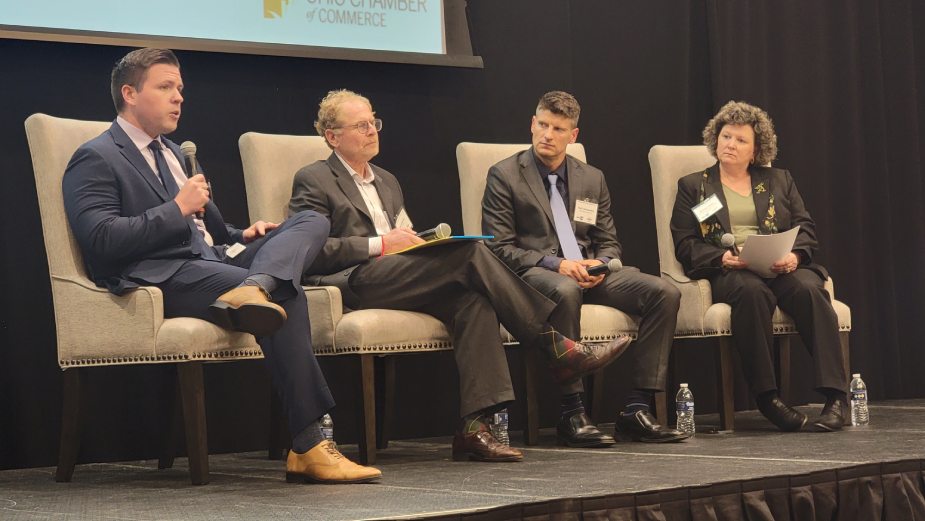Robotics Clubs Let Students Be Part of the Team
YOUNGSTOWN, Ohio – For senior Ellie Teneva, celebrating a big win at the Mahoning Valley VEX Robotics League tournament with her Struthers High School teammates was much bigger than the competition.
Teneva and her family moved to the United States from Bulgaria when she was in seventh grade. She found her place with robotics.
“I didn’t have anything to do here because I didn’t have any friends or a passion,” Teneva says. “I found robotics and that was it.”
The Struthers robot has metallic pieces, gears, wheels and an electronic mechanism that makes the creation function. Students operated the robot to complete objectives within a 12-by-12-foot arena at the competition held Feb. 17 at the Mahoning County Career and Technical Center.
Struthers beat 28 other schools from the Mahoning Valley to earn one of three spots at this year’s Ohio VEX Robotics High School State Championship March 12 at the Marion County Fairgrounds and Veterans Memorial Coliseum.
MCCTC had two teams that secured placements as well. One of the teams joined with the Struthers team to secure the win at the competition.
After each team performs skills competitions and has oral presentations of their robotics project, the top-ranked teams pick another group to form an alliance for the elimination round.
“They’re working out their strategies to make sure they don’t have that loss,” says Walter Baber, MCCTC engineering and robotics instructor.
Robots are tested to ensure they have all the necessary equipment to participate in the trials.
Teams run their 15-second autonomous and controlled programs to accumulate as many points as they can during two minutes of competition.
There is a blue and a red area on either side of the arena where mobile goals, or objects, are secured by the robot and placed on a teetering platform that must be balanced. It coincides with this year’s VEX theme of Tipping Point.
Other goals can be placed by a robot in a team’s zone to accumulate points as well, along with putting plastic doughnuts on the mobile goals.
MCCTC senior Dominic DiMailo says the competition gives him a sense of accomplishment. His team has rebuilt its robot three times since the beginning of the school year.
“I really enjoy that fast-paced nature,” he says.
Teneva says she loves adapting to the different situations, similar to the work of an engineer, which she aspires to become.
“There’s never only one solution to a problem,” she says. “There’s always multiple solutions. VEX is a great competition to teach you that.”
Teneva and her Struthers teammates stay after school until 8 p.m. each evening, fine-tuning their robots.
“It’s all worth it,” she says. “Once you love something, you want to give it your all.”
Purpose of competition
First (For Inspiration and Recognition of Science and Technology) offers robotics competitions, league challenges, technology and Lego competitions.
Andy Yantes, First senior mentor for Ohio, leads several programs in the Austintown area.
The nonprofit was founded in 1989, modeling athletics by applying engineering to a competitive event, which became robotics, Yantes says.
“If you heard it from the outside, you would think there was a basketball game or something going on inside the gymnasium. But it’s a robotics competition,” he says.
VEX Robotics has students design, program, test and build a robot to complete a new task every year, Baber says. The idea of competitions is for students to learn from their mistakes.
“The beauty of VEX to me, as an educator, is when we come home from that first competition. They can tear it apart and start all over again,” Baber says. “Now that they’ve seen what other people are doing, they’ve seen what doesn’t work on their robot and they can get rid of that and add it to the ideas that do work.
“Then, they go through the whole process again. It’s a constant cycle for them, which is the engineering design process.”
Teaching process

Jim Pluchinsky, Springfield Intermediate School science and robotics teacher, follows the Project Lead The Way curriculum, which creates pathways in STEM-related fields and provides teachers with the tools to engage their students.
There are 24 students involved in the VEX Robotics program with the Springfield teacher’s encouragement.
“Showing my enthusiasm for the program went a long way to recruiting kids to join the robotics club,” Pluchinsky says.
These robots start out 18 inches high, wide and deep and can expand to 36 inches once they are in action, says Austintown Fitch High School senior Ryan Wilt. Students start building the robots in August for competitions later in the school year.
“My best way to describe it is, they’re sort of like Legos except you use real nuts and bolts,” he says. “There are drilled holes and specific metal pieces. You can cut and bend those and put them together. That’s how you make these robots.”
VEX allows students to code their robots so they can move with controllers similar to what you’d see used with video games or autonomously.
“We use a version of C++ [coding system] to communicate with the brain on the robot which all the motors plug into,” Wilt says. “We can give that brain commands and tell it what to do based on certain inputs from our controllers.”
The First high school robotics program has 120-pound machines that perform feats such as traversing from a five-foot bar and shooting a nine-inch tennis ball into a goal eight-and-a-half feet in the air.
Unlike the VEX robots, which have prepackaged items, the First robots are built from scratch from aluminum parts welded together.
“We’re not allowed any prefab pieces we cannot use next year,” Yantes says. “If we fabricated it and physically made it, I can’t use it next year. So we start from scratch every year with that program.”
Cost of robotics
Austintown Fitch STEM teacher Robert Wyant says the school’s robotics club received a $20,000 grant at the end of last school year from Howmet Aerospace for a program that costs about $5,000 a year.
“That has been greatly supported in funding this program because the program fluctuates in price every year, depending on how many competitions there are, what parts they need, what breaks and things like that,” he says.

The MCCTC program has about 45 students in its 11th- and 12th-grade programs with a budget of $5,000 per year. There are six to eight students per team with competition registration fees ranging from $85 to $160 per team.
“We go to 12 competitions per year per season. So that’s 12 weekends that the students give up,” says Walter Baber, the school’s engineering and robotics instructor. “We travel as far as three hours away to compete at regional events to qualify for state.”
First runs robotics programs from kindergarten through high school in the Austintown area and some 100 students are in all four programs. His program is self-funded, relying on grants and fundraisers with a $36,000 budget.
“I don’t want to ever leave any kid behind just because there’s a financial responsibility,” Yantes says.
What they will learn
Yantes tells how one of his former students has a summer internship at Bell Textron Inc. in Fort Worth, Texas. The Youngstown State University mechanical engineering student will be working on the next generation of military helicopters while he’s there.
Without the First program in Austintown, the student told Yantes, this opportunity wouldn’t have been possible, he says.
Austintown Fitch junior Carlos Candelaria is in the U.S. Air Force’s Reserve Officers’ Training Corps and aspires to be an airplane mechanic.
Learning robotics helped him focus on problem-solving and critical thinking. That drove him to do his schoolwork instead of playing video games.
“For Springfield seventh grader Ally Guerriero, this experience has opened up possibilities for her and more than a half dozen other females in the robotics course.
“There’s a ton of jobs I didn’t realize that I could do, like engineering,” she says. “I never would have thought about that if I hadn’t taken this class.”
Pictured at top: Members of the top two teams in the Feb. 17 robotics competition at MCCTC are seniors Elion Oliver, Dominic DiMailo, Zac Pflug and Struthers junior Jacob Green, freshman Paul Armour, senior Ellie Teneva and senior Nate Slaven. They are advancing to the state championship March 12 in Marion.
Copyright 2024 The Business Journal, Youngstown, Ohio.



